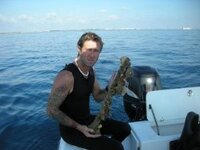FISHEYE
Bronze Member
- Feb 27, 2004
- 2,333
- 400
- Detector(s) used
- Chasing Dory ROV,Swellpro Splash 2 pro waterproof drone,Swellpro Spry+ wa,Wesmar SHD700SS Side Scan Sonar,U/W Mac 1 Turbo Aquasound by American Electronics,Fisher 1280x,Aquasound UW md,Aqua pulse AQ1B
- Primary Interest:
- All Treasure Hunting
http://biz.yahoo.com/bw/080819/20080819005825.html?.v=1
NEW YORK--(BUSINESS WIRE)--Seafarer Exploration Corp. (OTCBB: SFRX - News) announced today that the company believes it has identified the North boundary of the wreck.
Source: Seafarer Exploration Corp.
· An Iron Fastner artifact "Reef Dawg", one of our divers, holds one of the many artifacts found which is believed to be an iron fastner that held the wooden structural parts of the ship together. (Photo: Business Wire). View Multimedia Gallery
Lead diver Sean Murphy states, "We are confident that we have established the North Boundary of our treasure recovery site. We believe we have a defined and controlled search area to work within."
The Seafarer team is investigating the remains of a late 16th and early 17th century vessel. "We are on a very good trail of material that has all the indicators that one looks for in this type of shipwreck; pottery, lead sheathing, iron ships fittings and hardware all indicate this time period. The shipwreck is also on the track of vessels used by Spain to ferry commercial products from the New World back to Spain. These include the mineral wealth in the form of gold and silver," said Jim Sinclair, MA renowned archaeologist. Seafarer Exploration Corp. is conducting systematic searches under agreements with the State of Florida's Bureau of Archaeological Research and with the Florida Department of Environmental Protection.
Sinclair further says, "It is very exciting to be on this shipwreck with a crew that is dedicated to solving this mystery. In truth what we are doing is conducting a 400 year old forensic crime scene investigation. The area to the south of the anchor is even more exciting as the entire area is covered in ballast (river rocks used to weight and stabilize the vessel) and reads on metal detectors. So far surface finds have included iron ship fittings, lead sheathing, and shards of utilitarian potters known as "The Olive Jar", and musket balls. There is a layer that originally looked like bedrock, but when broken through we discovered another layer of ballast and associated material were directly underneath. The very next place we investigate may hold a king’s ransom, we just do not know and that keeps us out there digging."
NEW YORK--(BUSINESS WIRE)--Seafarer Exploration Corp. (OTCBB: SFRX - News) announced today that the company believes it has identified the North boundary of the wreck.
Source: Seafarer Exploration Corp.
· An Iron Fastner artifact "Reef Dawg", one of our divers, holds one of the many artifacts found which is believed to be an iron fastner that held the wooden structural parts of the ship together. (Photo: Business Wire). View Multimedia Gallery
Lead diver Sean Murphy states, "We are confident that we have established the North Boundary of our treasure recovery site. We believe we have a defined and controlled search area to work within."
The Seafarer team is investigating the remains of a late 16th and early 17th century vessel. "We are on a very good trail of material that has all the indicators that one looks for in this type of shipwreck; pottery, lead sheathing, iron ships fittings and hardware all indicate this time period. The shipwreck is also on the track of vessels used by Spain to ferry commercial products from the New World back to Spain. These include the mineral wealth in the form of gold and silver," said Jim Sinclair, MA renowned archaeologist. Seafarer Exploration Corp. is conducting systematic searches under agreements with the State of Florida's Bureau of Archaeological Research and with the Florida Department of Environmental Protection.
Sinclair further says, "It is very exciting to be on this shipwreck with a crew that is dedicated to solving this mystery. In truth what we are doing is conducting a 400 year old forensic crime scene investigation. The area to the south of the anchor is even more exciting as the entire area is covered in ballast (river rocks used to weight and stabilize the vessel) and reads on metal detectors. So far surface finds have included iron ship fittings, lead sheathing, and shards of utilitarian potters known as "The Olive Jar", and musket balls. There is a layer that originally looked like bedrock, but when broken through we discovered another layer of ballast and associated material were directly underneath. The very next place we investigate may hold a king’s ransom, we just do not know and that keeps us out there digging."




